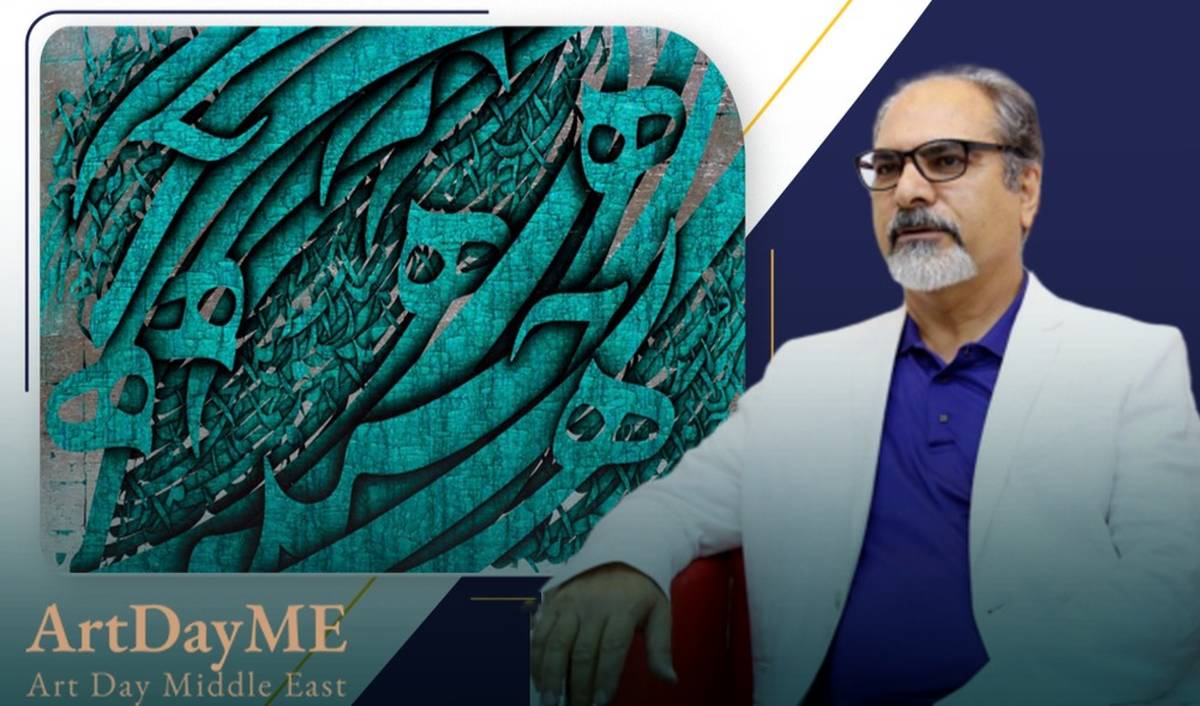
Calligraphy by Ali Shirazi in Honor of Avicenna
The famous Middle Eastern calligrapher and painter Ali Shirazi has a very peculiar green piece of art that is reminiscent of a poem by the illustrious Iranian physician and philosopher Avicenna. The backstory of his work is fascinating.
ArtDayME: Ali Shirazi's unique green calligraphic painting, measuring 180 by 230 cm and created on canvas using acrylic technique, contains stunning visual elements in addition to an intriguing study of content, some of which are discussed in this article.
1: With a multi-layered composition, Shirazi's breathtaking green calligraphic painting appears to be a reflection of an iconic poem ascribed to the renowned Iranian physician and philosopher. Through the use of huge drawn letters that catch the eye, the showcase design can lead the audience to the inner layers of the work. The tiny lines become more noticeable the closer you look.
The depth of the piece has been greatly enhanced by its silver background, distinct green tones, and the way the letters dance in different directions.
2: In an interview, Shirazi said that a poem attributed to Avicenna served as the inspiration for his calligraphic artwork. The profundity of the poem's deep meaning was borrowed by the skilled calligrapher. Shirazi's proficiency in calligraphy, traditional as well as contemporary, is evident in the amazing technique he used to write the letters, even in their smallest forms.

3: His writing approach is compositional, treating the subject as though it were a four-sided piece. It's an interesting idea by the artist to create and arrange the letters such that the vertical and horizontal sides have the right amount of stability and beauty.
4: In reference to the concept behind his artwork, Shirazi said: "Many years ago, during a visit to my hometown of Shiraz, I was given the opportunity to tour Ibn Sina's transplant hospital, which was established by a group of generous and honorable Shirazis."
He went on: "The hospital was going to open at that point. I found it intriguing that the valued donors had also given careful consideration to the building's architectural features. They constructed an outstanding structure with forward-thinking design principles, which is characteristic of the Shirazi community."
Shirazi clarified: "I pledged to present a piece worthy of the architecture because I desired to be a part of such a humanitarian effort. I started the task as soon as I got back to Tehran, and it was immediately dedicated to both the hospital and those donors."
5: The audience's interpretation of the piece may change due to its captivating origin narrative. As an illustration, when you look at the piece from the inside and the bottom layers with the small letters, you may notice that the smaller pieces come together to form well-shaped letters.
6: The unique green hue of the work of art also takes on a deeper significance. Despite the fact that green is a color associated with calm and peace, it is evident from the previously described backstory that master Shirazi paid attention to the color's associations with hospitals, doctor uniforms, and finding harmony with the setting. The artist has honored people who look after human health by using this color.
Selecting this color involves other crucial factors. In contrast to many of Shirazi's other pieces, this one uses a silver patina as the backdrop color to give the impression of brightness. The artist brightened it up with a range of greens, perhaps because the creative lighting settings weren't ready for the painting because it was due to be presented in a hospital.

7: The calligraphies of Shirazi are becoming immensely popular in the Middle Eastern art business. Apart from the Iranian artist's historic $60,000 Christie's auction result in 2012, he has fetched staggering amounts for highly coveted pieces at Bonhams London and other auction houses; samples of his past sales may be seen on trustworthy websites such as Art Price.
https://images.app.goo.gl/KfPodCaRJG7eBnGg9
Master Shirazi's works are held in many of the Middle East's priceless gems, such as the collections of prominent Arab poet and writer, Mohammad Al Murr in the United Arab Emirates; the Al Owais Institute in Dubai; the Anwar Gargash collection in Dubai; the Juma Al Majid collection in Dubai; the museums in Sharjah, Doha, and Qatar; the most significant private collectors, such as Pasargad Bank of Iran; and religious collections in Iran, including Tehran's Quran Museum and Imam Ali Religious Arts Museum.

LEAVE A RELPY